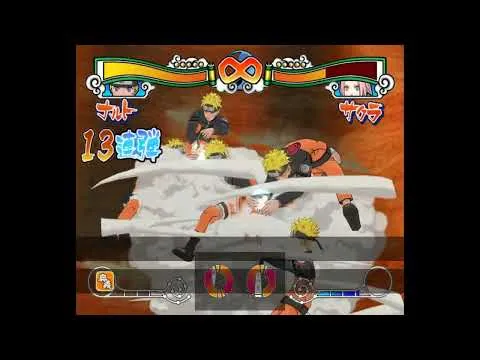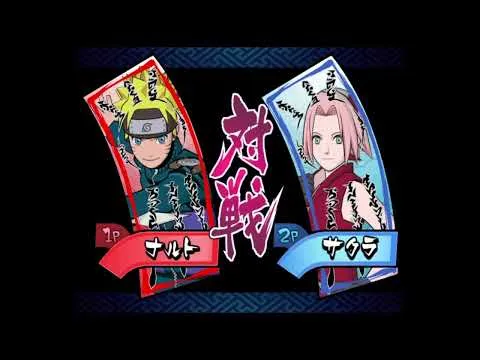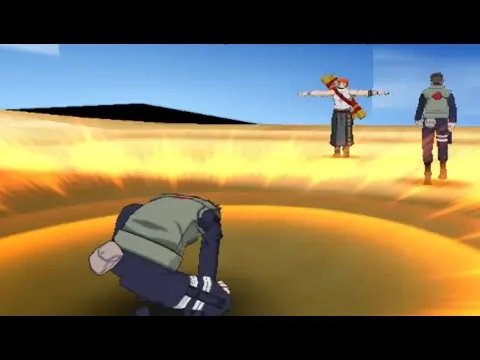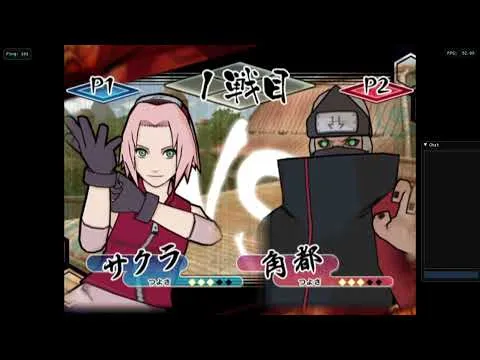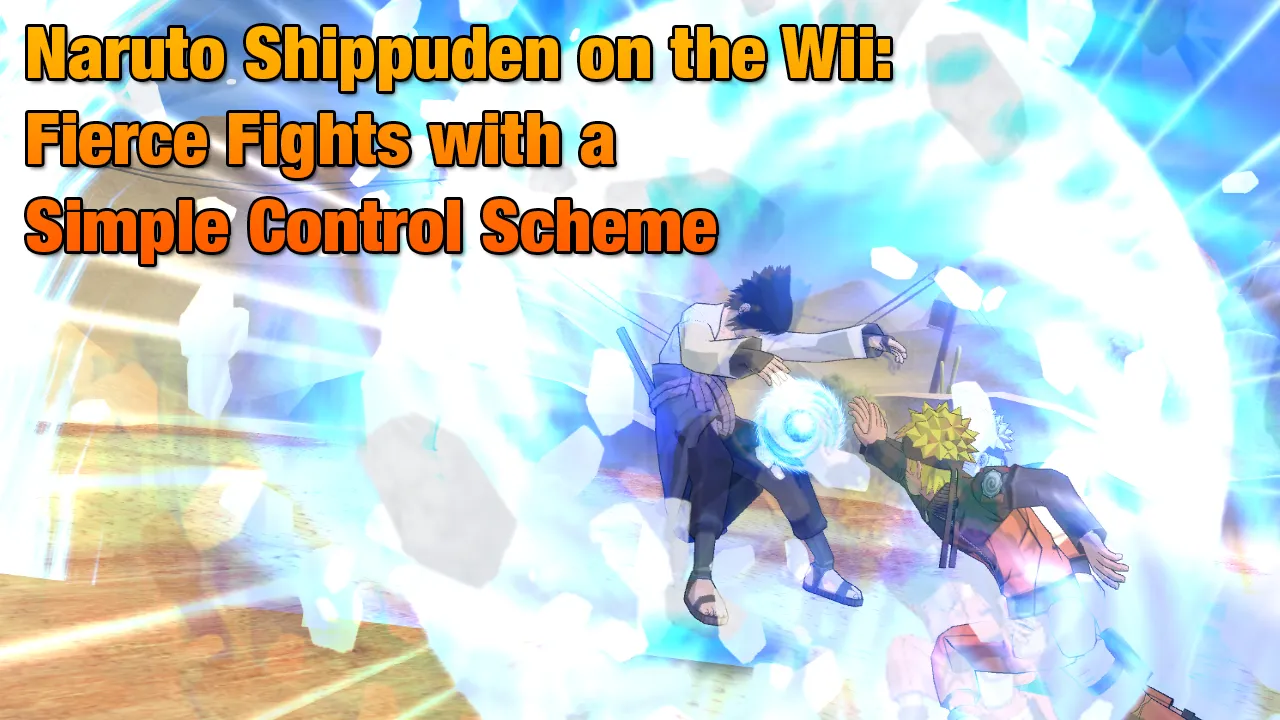

Sorry to keep you waiting these few days, I have some issues with my fiber internet connection 😅
Last year I had already talked about the first Naruto Clash of Ninja game for the Gamecube, and then the last game in the series for the Gamecube. So now its time to finally move on the Shippuden era of games!
For a quick refresher, the Clash of Ninja games (Gekitou Ninja Taisen in Japan) are characterized by being traditional 3D fighters a la Tekken or Virtua Fighter with simple controls (two buttons for attacks, one for throw, one for super attacks, and two for sidesteps; no motion inputs needed) rather than platform fighters (Ultimate Ninja) and arena fighters (Ultimate Ninja Storm), which makes them stand out by being a bit more complex when you get to it.
Just think about the difference between DBZ Budokai and Budokai Tenkaichi if you happened to play both games. And by the way, all of these games are compatible with Classic Controller, Gamecube Controller, and even the sideways Wiimote, so you can absolutely this without having to fight with motion controls for specific stuff (except for hand signs, but I never used those for that reason).
Since all other large adventures like Uzumaki Chronicles, Rise of the Ninja and all Ultimate Ninja games (including the Storm games) have been exclusive to Playstation and Xbox consoles, this entire series of games would be the only good options for Gamecube and Wii owners. While the content for these types of games to play alone might not be much after enough time (this is a topic I wanted to tackle soon), they definitely offer some good value for playing with others, and you'd be surprised at the weird variety between all the games released.
An odd footnote
Back when I talked about GNT4, I mentioned that out of the four Gamecube games, only two were localized, and the last two were replaced overseas with new games for the Wii. While Revolution 1 resembled the third Gamecube game on the surface, Revolution 2 went with an original story and presentation rather than copying the fourth Gamecube game. And these Wii games would have some few new mechanics as they were carried over from...
The Naruto Shippuden: Gekitou Ninja Taisen EX games
In Japan, after the four Gamecube games released (that covered all the canon arcs pre-timeskip), the GNT EX games would follow next, covering the new story introduced in Naruto Shippuden.
The first EX game suffers the same issue that the first GNT/CON game did: It only could work with the first arc of the anime available so the roster is small; not as small as CON1 but still a bit of a tiny roster compared to most games before and after it.
Coolest thing this one had though was Naruto's improvised super with clones that got replaced by the Giant Rasengan technique (since he learns that after the story seen here).
But after that, EX2 expanded the cast a lot and content, and then EX3 added more modes, a Story mode with top-down free roaming segments, and brought some new characters added in Revolution 2 (though this is only the official characters and none of the original ones made for that game). Oddly enough though, none of the EX games had widescreen support at all. It also has a story mode with free-roaming sections for some reason, which is interesting to say the least for what you'd expect for these games.
I'd say that EX3 is definitely a fun game after having sit and played it with a friend that doesn't like playing much these games, my brother which I had played a lot them with, and then with an East Coast player that labs combos a lot with this game. And yet all three of those times it was fun, though for different reasons.
There's some really goofy things like the stages by default having hazards, some characters having really high damage for their supers, Sasuke being able to teleport around a lot without spending chakra, and so on, but at least these funny things allow it to stand out a bit more when revisited after the existence of...
Naruto Shippuden: Clash of Ninja Revolution 3
This is the one that people overseas got as the only Shippuden game in the series, and yet it happened to be quite more than a localized version of EX3. The Revolution 2 original characters were brought back with the EX3 cast (minus the classic Naruto and Sasuske), but some characters only seen again since Rev2 or weren't in EX3 were also added, like Anko, Chiyo and Anbu Kakashi. It boasts the biggest roster in the series so far, only second to what came next.
Revolution 3 goes for a story mode similar to Rev 2, only that it follows the canonical Rescue of the Kazekage arc where the Akatsuki kidnap Gaara and the gang have to get him back. It has some cool ideas like the Sakura and Chiyo vs Sasori fight, the Guy mirror match where you have to figure out how to defeat an enemy mimicking your exact moves...and the final battle being yet again a super-armor powered enemy that you have to finish off with a super (which also happened in Revolution 2).
While some things are a bit odd, it certainly makes for a neat package with all the additions from Revolution 2 (characters, Tag Team, Widescreen, Paper Bombs) combined with the content from EX3 (Post-Timeskip characters and movesets). And as with most fighting games, it is still as entertaining as it can get with a friend that's on par with you.
And then there's...
Naruto Shippuden Gekitou Ninja Taisen Special
Special is the last installment of the series, exclusive to Japan and based off Revolution 3. It does NOT have the original Rev 2 characters, but everybody else is back and there's more new characters: Minato, Killer Bee, the Raikage, Naruto in Sage Mode...and Ino, who hadn't been in a game since Rev 2 for whatever reason (she wasn't in the EX games or Rev3)
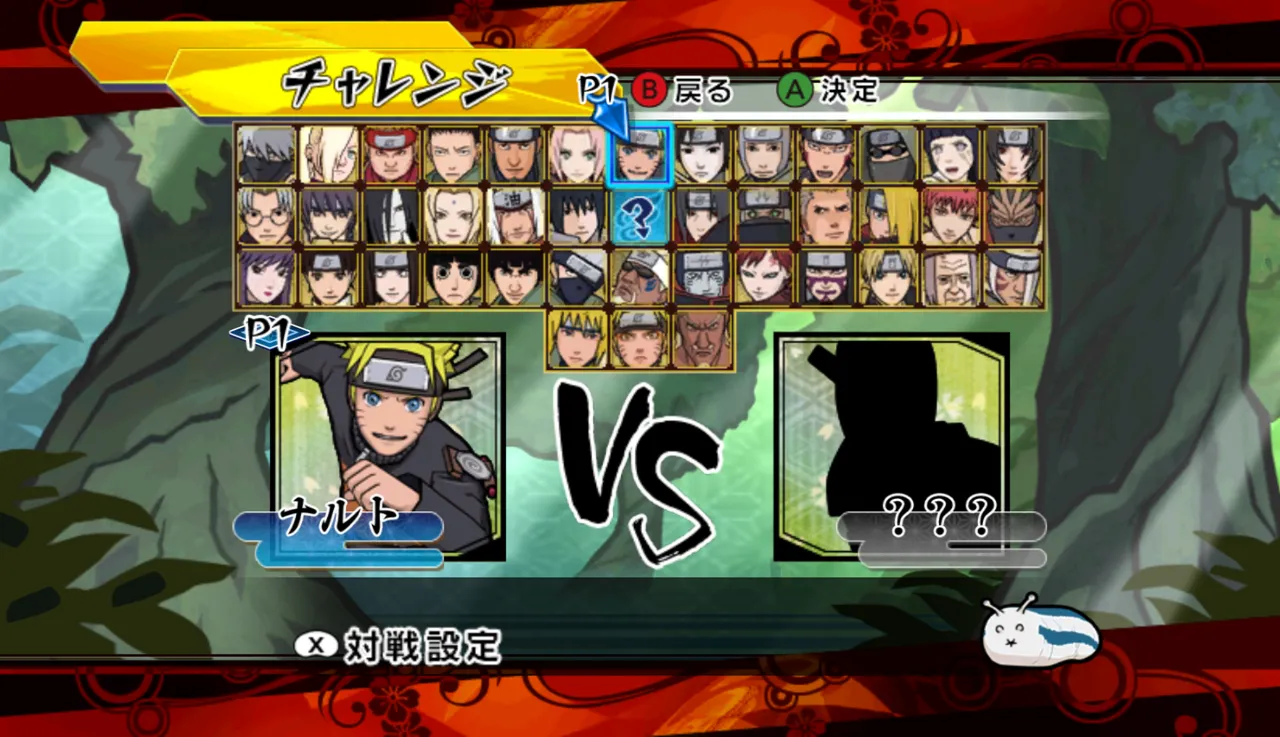
Most new characters (except Ino) have some cool but ridiculous stuff: Raikage hitting like tank with occasional electricity armor, Bee has a pinch transformation with the Eight Tails aura, Sage Naruto needs to use a move to recharge his chakra manually...but he gains a lot of powerful moves (that use up chakra) in exchange, and Minato being shown as an insanely quick fighter, is quite ridiculous with his moves: His attack substitution is an instant strike rather than appearing in the air to slam you and his basic combo has him hit you around teleporting like a DBZ character.
Oh, and if you lose at the "Arcade" mode, you'll actually get kicked out on the spot. There's the main "Gekinin Road" single player mode where you do fights with three conditions to get more scrolls, which can be used to open paths in a character's playthrough.
The oddest change is that there's a special meter for substitutions now: Instead of using three bars of chakra to escape as a meter management decision, it is now more like a standard Burst meter in games like Guilty Gear as it is its own thing. You can keep your chakra when used, but you won't be able to regenerate this meter unless you get hit (while you could get chakra when attacking) so it makes chances to escape with it less frequent for winning players. The game itself also does away from the Obstacles and Transitions added since EX1, which means that there's more individual stages available from two halves of single stages being shown...but there's also some of those halves that are lost here.
Since it sort of changes a core mechanic in the series, some people that still play this one actually choose to play with a code that disables the bar and restores the classic "chakra for sub" system as they always knew of, which is what we played with on this online session (the bars are gone with a texture pack), but that aside, the game's presentation is quite polished and has the same roster as Rev3 (except for the Rev2 OCs).
Conclusion
Even against a more experienced player, the simple controls meaning that I could at least try to fight back with the basic combos and substitutions (the best way to get advantage in this game is to know longer strings or combos to get more damage out of a freshly subbed enemy). But there's definitely a fun factor in knowing how to extend your basic stuff and being able to dodge the opponent's substitution to start attacking again.
But it still can get tense when both just know already what to look out when playing: Try to get your attack strings in, break defense or find a way to avoid getting punished if your string is blocked (often by ending the string early to get out or start it again to catch them off-guard), fishing for throws, playing neutral with the projectiles, and most importantly: Know when is the right moment to substitute and baiting the enemy to sub out with a brief attack that lets you sidestep or run away from their substitution attack (if they decide to use one).
It is a simpler approach to a fighting game that might not have that much complexity for creativity due to the simple button scheme and combos (unless you learn Y-Cancel stuff to extend your combos), but if you get someone to adapt to the game style, it can still be great to play as the tension focuses on who can get a clean hit into a combo or super when it can be easy to leave yourself open, and using wisely your substitutions as you can try to get out quickly or not use it during one in case it isn't a long one/saving chakra for a super or escaping another combo.
...What about Dragon Blade Chronicles?
The only memory I have of playing that one is that I got a burned Rev3 copy once years ago, and while the box clearly had the Rev3 boxart printed, what was inside was DBC in Japanese. You can imagine my confusion when the battle mode only had Naruto and Sasuke playable and was nothing like these games. So that's all I can say about that one.
Thanks for reading!

Spanish translation with DeepL. All screenshots were captured by myself.
Español
Disculpa por dejarlos esperando estos días; he tenido problemas con el internet 😅
El año pasado ya hablé del primer juego de Naruto Clash of Ninja para Gamecube, y luego del último juego de la serie para Gamecube. Así que ha llegado el momento de pasar a la era Shippuden.
Para refrescar un poco la memoria, los juegos de Clash of Ninja (Gekitou Ninja Taisen en Japón) se caracterizan por ser juegos de lucha tradicionales en 3D, al estilo de Tekken o Virtua Fighter, con controles sencillos (dos botones para atacar, uno para lanzar, uno para los superataques y dos para esquivar; no es necesario introducir ningún movimiento) en lugar de juegos de lucha de plataformas (Ultimate Ninja) y de lucha en arenas (Ultimate Ninja Storm), lo que hace que destaquen por ser un poco más complejos cuando te pones a ello.
Piensa en la diferencia entre DBZ Budokai y Budokai Tenkaichi si llegas a jugar a ambos juegos. Y por cierto, todos estos juegos son compatibles con Classic Controller, Gamecube Controller, e incluso el Wiimote lateral, así que puedes absolutamente esto sin tener que pelearte con los controles de movimiento para cosas específicas (excepto para los signos de las manos, pero nunca los usé por esa razón).
Dado que el resto de grandes aventuras como Uzumaki Chronicles, Rise of the Ninja y todos los juegos de Ultimate Ninja (incluidos los de Storm) han sido exclusivos de las consolas Playstation y Xbox, toda esta serie de juegos serían las únicas buenas opciones para los poseedores de Gamecube y Wii. Aunque el contenido de este tipo de juegos para jugar en solitario podría no ser mucho después de bastante tiempo (este es un tema que quería abordar pronto), definitivamente ofrecen un buen valor para jugar con otros, y te sorprendería la extraña variedad entre todos los juegos lanzados.
Una extraña nota a pie de página
Cuando hablé de GNT4, mencioné que de los cuatro juegos de Gamecube, solo dos se localizaron, y los dos últimos se sustituyeron en el extranjero por nuevos juegos para Wii. Mientras que Revolution 1 se parecía en apariencia al tercer juego de Gamecube, Revolution 2 optó por una historia y una presentación originales en lugar de copiar el cuarto juego de Gamecube. Y estos juegos de Wii tendrían algunas pocas mecánicas nuevas, ya que se trasladaron de...
Los juegos de Naruto Shippuden: Gekitou Ninja Taisen EX
En Japón, tras el lanzamiento de los cuatro juegos de Gamecube (que cubrían todos los arcos argumentales anteriores al salto temporal), llegarían los juegos GNT EX, que cubrían la nueva historia introducida en Naruto Shippuden.
El primer juego EX tiene el mismo problema que el primer juego GNT/CON: Sólo podía funcionar con el primer arco del anime disponible, por lo que la plantilla era reducida; no tanto como la de CON1, pero seguía siendo un poco pequeña en comparación con la mayoría de juegos anteriores y posteriores.
Lo mejor que tenía este juego era el super improvisado de Naruto con clones que fue reemplazado por la técnica del Rasengan Gigante (ya que lo aprende después de la historia que se ve aquí).
Pero después de eso, EX2 amplió mucho el elenco y el contenido, y luego EX3 añadió más modos, un modo Historia con segmentos de recorrido libre de arriba hacia abajo, y trajo algunos nuevos personajes añadidos en Revolution 2 (aunque esto es sólo los personajes oficiales y ninguno de los originales hechos para ese juego). Curiosamente, ninguno de los juegos EX era compatible con la pantalla panorámica. También tiene un modo historia con secciones de juego libre por alguna razón, lo cual es cuanto menos interesante para lo que cabría esperar de estos juegos.
Yo diría que EX3 es definitivamente un juego divertido después de haberme sentado a jugarlo con un amigo al que no le gusta mucho jugar a estos juegos, con mi hermano con el que había jugado mucho a ellos, y luego con un jugador de la Costa Este que labs combos mucho con este juego. Y sin embargo las tres veces fue divertido, aunque por diferentes razones.
Hay cosas muy tontas, como que los escenarios tengan peligros por defecto, que algunos personajes tengan un daño muy alto para sus supers, que Sasuke pueda teletransportarse mucho sin gastar chakra, etc., pero al menos estas cosas divertidas permiten que destaque un poco más cuando se revisita después de la existencia de...
Naruto Shippuden: Clash of Ninja Revolution 3
Este es el que la gente de ultramar recibió como el único juego Shippuden de la serie, y sin embargo resultó ser bastante más que una versión localizada de EX3. Los personajes originales de Revolution 2 volvieron con el reparto de EX3 (menos los clásicos Naruto y Sasuske), pero también se añadieron algunos personajes que solo se habían vuelto a ver desde Rev2 o que no estaban en EX3, como Anko, Chiyo y Anbu Kakashi. Se trata del mayor plantel de la serie hasta la fecha, sólo superado por el siguiente.
Revolution 3 apuesta por un modo historia similar al de Rev 2, sólo que sigue el rescate canónico del arco Kazekage, en el que los Akatsuki secuestran a Gaara y la banda tiene que recuperarlo. Tiene algunas ideas interesantes, como la lucha de Sakura y Chiyo contra Sasori, el combate de espejos de Guy, en el que tienes que averiguar cómo derrotar a un enemigo que imita tus movimientos exactos... y la batalla final, que vuelve a ser contra un enemigo con superarmadura al que tienes que derrotar con una super (algo que también ocurría en Revolution 2).
Aunque algunas cosas son un poco extrañas, lo cierto es que el paquete está muy bien cuidado, con todos los añadidos de Revolution 2 (personajes, Tag Team, pantalla panorámica, bombas de papel) combinados con el contenido de EX3 (personajes y movimientos posteriores al Timeskip). Y como la mayoría de los juegos de lucha, sigue siendo tan entretenido como puede serlo con un amigo que esté a tu altura.
Y luego está...
Naruto Shippuden Gekitou Ninja Taisen Special
Special es la última entrega de la serie, exclusiva para Japón y basada en Revolution 3. NO tiene a los personajes originales de Rev 2, pero todos los demás están de vuelta y hay más personajes nuevos: Minato, Killer Bee, el Raikage, Naruto en modo Sage... e Ino, que no había aparecido en ningún juego desde Rev 2 por alguna razón (no estuvo en los juegos EX ni en Rev 3).

La mayoría de los personajes nuevos (excepto Ino) tienen cosas chulas pero ridículas: Raikage golpea como un tanque con una armadura eléctrica ocasional, Bee tiene una transformación de pellizco con el aura de las Ocho Colas, Sage Naruto necesita usar un movimiento para recargar su chakra manualmente... pero a cambio gana un montón de movimientos poderosos (que gastan chakra), y Minato, que se muestra como un luchador increíblemente rápido, es bastante ridículo con sus movimientos: Su ataque de sustitución es un golpe instantáneo en lugar de aparecer en el aire para golpearte y su combo básico hace que te golpee teletransportándose como un personaje de DBZ.
Ah, y si pierdes en el modo "Arcade", te expulsarán en el acto. También está el modo principal para un jugador, "Gekinin Road", en el que tienes que luchar con tres condiciones para conseguir más pergaminos, que se pueden usar para abrir caminos en la historia de un personaje.
El cambio más extraño es que ahora hay un medidor especial para las sustituciones: En lugar de usar tres barras de chakra para escapar como decisión de gestión del medidor, ahora es más parecido al medidor Burst estándar de juegos como Guilty Gear, ya que es algo propio. Puedes conservar tu chakra cuando lo usas, pero no podrás regenerar este medidor a menos que te golpeen (mientras que podías obtener chakra al atacar), así que hace que las oportunidades de escapar con él sean menos frecuentes para los jugadores ganadores. El juego en sí también prescinde de los obstáculos y las transiciones añadidos desde EX1, lo que significa que hay más fases individuales disponibles a partir de dos mitades de fases individuales que se muestran... pero también hay algunas de esas mitades que se pierden aquí.
Dado que cambia en cierto modo una mecánica fundamental de la serie, algunas personas que aún juegan a este título optan por jugar con un código que desactiva la barra y restaura el clásico sistema de "chakra por sub" que siempre conocieron, que es con lo que jugamos en esta sesión en línea (las barras han desaparecido con un paquete de texturas), pero aparte de eso, la presentación del juego está bastante pulida y tiene la misma plantilla que Rev3 (excepto los OC de Rev2).
Conclusión
Incluso contra un jugador más experimentado, los sencillos controles significaban que al menos podía intentar defenderme con los combos y sustituciones básicos (la mejor forma de conseguir ventaja en este juego es conocer cadenas o combos más largos para conseguir más daño de un enemigo recién subido). Pero definitivamente hay un factor de diversión en saber cómo extender tus cosas básicas y ser capaz de esquivar la sustitución del oponente para empezar a atacar de nuevo.
Pero aún así puede resultar tenso cuando ambos saben ya qué deben tener en cuenta al jugar: Tratar de meter tus cadenas de ataque, romper la defensa o encontrar una forma de evitar ser castigado si tu cadena es bloqueada (a menudo terminando la cadena antes de tiempo para salir o empezarla de nuevo para pillarles desprevenidos), pescar lanzamientos, jugar neutral con los proyectiles, y lo más importante: Saber cuándo es el momento adecuado para sustituir y provocar al enemigo para que sustituya con un breve ataque que te permita esquivar o huir de su ataque de sustitución (si decide utilizar uno).
Es una aproximación más simple a un juego de lucha que puede no tener mucha complejidad para la creatividad debido al simple esquema de botones y combos (a menos que aprendas cosas de Y-Cancel para extender tus combos), pero si consigues que alguien se adapte al estilo de juego, ...pero si consigues que alguien se adapte al estilo de juego, puede ser un gran juego, ya que la tensión se centra en quién puede conseguir un golpe limpio en un combo o super cuando puede ser fácil dejarse al descubierto, y usar sabiamente tus sustituciones, ya que puedes intentar salir rápidamente o no usarlas durante uno en caso de que no sea largo/ahorrar chakra para un super o escapar de otro combo.
...¿Qué hay de Dragon Blade Chronicles?
El único recuerdo que tengo de jugar a ese juego es que una vez me regalaron una copia quemada de Rev3 hace años, y aunque la caja tenía claramente impreso el boxart de Rev3, lo que había dentro era DBC en japonés. Puedes imaginar mi confusión cuando el modo batalla solo tenía Naruto y Sasuke jugables y no se parecía en nada a estos juegos. Así que eso es todo lo que puedo decir al respecto.
Gracias por leernos.

Traducción al español hecha con DeepL. Todas las fotos capturadas por mí.
